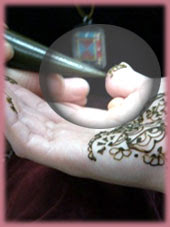 A caller today was asking about the henna powder I sell. The caller wanted to know if it was black henna. I am blogging my answers to all his questions for those who are new to the henna process, as well as for those who are shopping for "black" henna.
A caller today was asking about the henna powder I sell. The caller wanted to know if it was black henna. I am blogging my answers to all his questions for those who are new to the henna process, as well as for those who are shopping for "black" henna.
First, I do not sell black henna... and to the best of my understanding there is no such thing. Henna powder is the result of grinding fresh henna, leaves. The resulting color left on the skin may be affected by the region where the henna was grown, the ground and climate. Fresh henna gives the deepest color, and good artists all have a special recipe. I publish mine on line for your review.
Chemicals may be added to the henna powder before it is packages & shipped to make it dye the hair different colors, but this is not the kind of henna I use for body art. I have heard of lots of things that may be added to henna powders that are sold for body art, and it is important to know that some of these chemicals that can burn and scar the skin.
I sell Jamila henna that is harvest fresh, finely ground, fragrant & does not contain any additives. The first photo in this post is a picture of the henna paste being applied to the skin using a henna cone.
Most photos in this blog show pictures of henna past still on the skin. I am sometimes able to publish photos of the finished color, which will always be a shade of red to reddish brown. This paste will be removed after a period of time, and the finished color will develop over the next 48 hours. If a client takes very good care of her henna tattoo, allows the paste to remain on the skin for six hours or more, takes care to keep the henna moist, using lemon sugar glaze, or just to remain outdoors in the the sun, it is possible to get a very dark finished color that seems to be black.
If a client takes very good care of her henna tattoo, allows the paste to remain on the skin for six hours or more, takes care to keep the henna moist, using lemon sugar glaze, or just to remain outdoors in the the sun, it is possible to get a very dark finished color that seems to be black.
This color is really a deep black cherry red. The second picture in this post shows the results of fresh henna powder, mixed with lemon juice, herbs and essential oils to create the paste I use for my clients.
As you can see the finished color is darkest in the center of the palm. The palm always takes henna best, the color will be lighter as the pattern moves up the arm.
I always provide an informed consent listing all ingredients in the paste as well as offering aftercare instructions and tips to get good color. Henna is a heat activated body dye, so I try to offer henna tattoo in the summer time. Other posts in this blog will have photos of henna that is wrapped to help give the darkest color possible.
I hope this post is helpful. Be sure to visit the FAQ page at Spirit Vision Henna for more information.
Wednesday, January 07, 2009
Black Henna FAQ
Subscribe to:
Post Comments (Atom)




1 comment:
I've been researching henna lately (hence how I stumbled across this website), and supposedly there is such a thing as black henna. It is synthetically produced/added to, and is oftentimes irritating or harmful. Either way, I won't use it!
Post a Comment